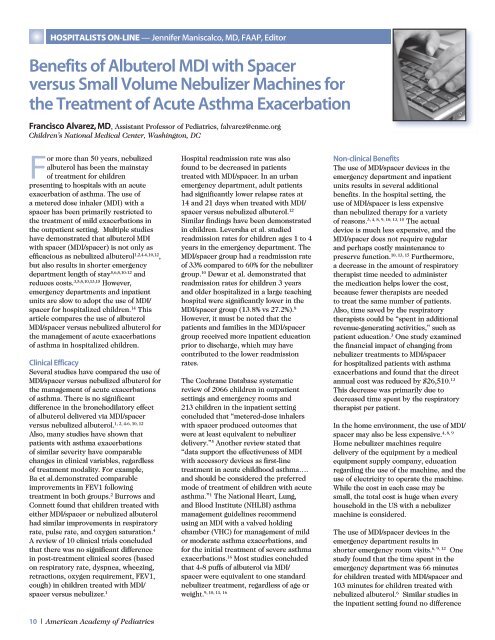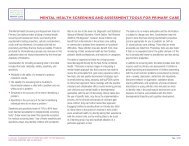Susan Wu, MD, FAAP, Editor - American Academy of Pediatrics
Susan Wu, MD, FAAP, Editor - American Academy of Pediatrics
Susan Wu, MD, FAAP, Editor - American Academy of Pediatrics
Create successful ePaper yourself
Turn your PDF publications into a flip-book with our unique Google optimized e-Paper software.
hoSPitaLiStS oN-LiNe — Jennifer Maniscalco, <strong>MD</strong>, <strong>FAAP</strong>, <strong>Editor</strong><br />
Benefits <strong>of</strong> Albuterol <strong>MD</strong>I with Spacer<br />
versus Small Volume Nebulizer Machines for<br />
the Treatment <strong>of</strong> Acute Asthma Exacerbation<br />
Francisco Alvarez, <strong>MD</strong>, Assistant Pr<strong>of</strong>essor <strong>of</strong> <strong>Pediatrics</strong>, falvarez@cnmc.org<br />
Children’s National Medical Center, Washington, DC<br />
For more than 50 years, nebulized<br />
albuterol has been the mainstay<br />
<strong>of</strong> treatment for children<br />
presenting to hospitals with an acute<br />
exacerbation <strong>of</strong> asthma. The use <strong>of</strong><br />
a metered dose inhaler (<strong>MD</strong>I) with a<br />
spacer has been primarily restricted to<br />
the treatment <strong>of</strong> mild exacerbations in<br />
the outpatient setting. Multiple studies<br />
have demonstrated that albuterol <strong>MD</strong>I<br />
with spacer (<strong>MD</strong>I/spacer) is not only as<br />
efficacious as nebulized albuterol 1,2,4-6,10,12 ,<br />
but also results in shorter emergency<br />
department length <strong>of</strong> stay 5,6,8,10-12 and<br />
reduces costs. 3,5,8,10,13,15 However,<br />
emergency departments and inpatient<br />
units are slow to adopt the use <strong>of</strong> <strong>MD</strong>I/<br />
spacer for hospitalized children. 14 This<br />
article compares the use <strong>of</strong> albuterol<br />
<strong>MD</strong>I/spacer versus nebulized albuterol for<br />
the management <strong>of</strong> acute exacerbations<br />
<strong>of</strong> asthma in hospitalized children.<br />
Clinical Efficacy<br />
Several studies have compared the use <strong>of</strong><br />
<strong>MD</strong>I/spacer versus nebulized albuterol for<br />
the management <strong>of</strong> acute exacerbations<br />
<strong>of</strong> asthma. There is no significant<br />
difference in the bronchodilatory effect<br />
<strong>of</strong> albuterol delivered via <strong>MD</strong>I/spacer<br />
versus nebulized albuterol.<br />
1, 2, 4-6, 10, 12<br />
Also, many studies have shown that<br />
patients with asthma exacerbations<br />
<strong>of</strong> similar severity have comparable<br />
changes in clinical variables, regardless<br />
<strong>of</strong> treatment modality. For example,<br />
Ba et al.demonstrated comparable<br />
improvements in FEV1 following<br />
treatment in both groups. 2 Burrows and<br />
Connett found that children treated with<br />
either <strong>MD</strong>I/spacer or nebulized albuterol<br />
had similar improvements in respiratory<br />
rate, pulse rate, and oxygen saturation. 4<br />
A review <strong>of</strong> 10 clinical trials concluded<br />
that there was no significant difference<br />
in post-treatment clinical scores (based<br />
on respiratory rate, dyspnea, wheezing,<br />
retractions, oxygen requirement, FEV1,<br />
cough) in children treated with <strong>MD</strong>I/<br />
spacer versus nebulizer. 1<br />
10 | <strong>American</strong> <strong>Academy</strong> <strong>of</strong> <strong>Pediatrics</strong><br />
Hospital readmission rate was also<br />
found to be decreased in patients<br />
treated with <strong>MD</strong>I/spacer. In an urban<br />
emergency department, adult patients<br />
had significantly lower relapse rates at<br />
14 and 21 days when treated with <strong>MD</strong>I/<br />
spacer versus nebulized albuterol. 12<br />
Similar findings have been demonstrated<br />
in children. Leversha et al. studied<br />
readmission rates for children ages 1 to 4<br />
years in the emergency department. The<br />
<strong>MD</strong>I/spacer group had a readmission rate<br />
<strong>of</strong> 33% compared to 60% for the nebulizer<br />
group. 10 Dewar et al. demonstrated that<br />
readmission rates for children 3 years<br />
and older hospitalized in a large teaching<br />
hospital were significantly lower in the<br />
<strong>MD</strong>I/spacer group (13.8% vs 27.2%). 8<br />
However, it must be noted that the<br />
patients and families in the <strong>MD</strong>I/spacer<br />
group received more inpatient education<br />
prior to discharge, which may have<br />
contributed to the lower readmission<br />
rates.<br />
The Cochrane Database systematic<br />
review <strong>of</strong> 2066 children in outpatient<br />
settings and emergency rooms and<br />
213 children in the inpatient setting<br />
concluded that “metered-dose inhalers<br />
with spacer produced outcomes that<br />
were at least equivalent to nebulizer<br />
delivery.” 5 Another review stated that<br />
“data support the effectiveness <strong>of</strong> <strong>MD</strong>I<br />
with accessory devices as first-line<br />
treatment in acute childhood asthma….<br />
and should be considered the preferred<br />
mode <strong>of</strong> treatment <strong>of</strong> children with acute<br />
asthma.” 1 The National Heart, Lung,<br />
and Blood Institute (NHLBI) asthma<br />
management guidelines recommend<br />
using an <strong>MD</strong>I with a valved holding<br />
chamber (VHC) for management <strong>of</strong> mild<br />
or moderate asthma exacerbations, and<br />
for the initial treatment <strong>of</strong> severe asthma<br />
exacerbations. 16 Most studies concluded<br />
that 4-8 puffs <strong>of</strong> albuterol via <strong>MD</strong>I/<br />
spacer were equivalent to one standard<br />
nebulizer treatment, regardless <strong>of</strong> age or<br />
9, 10, 11, 16<br />
weight.<br />
Non-clinical Benefits<br />
The use <strong>of</strong> <strong>MD</strong>I/spacer devices in the<br />
emergency department and inpatient<br />
units results in several additional<br />
benefits. In the hospital setting, the<br />
use <strong>of</strong> <strong>MD</strong>I/spacer is less expensive<br />
than nebulized therapy for a variety<br />
<strong>of</strong> reasons. 3, 4, 8, 9, 10, 13, 15 The actual<br />
device is much less expensive, and the<br />
<strong>MD</strong>I/spacer does not require regular<br />
and perhaps costly maintenance to<br />
preserve function. 10, 13, 15 Furthermore,<br />
a decrease in the amount <strong>of</strong> respiratory<br />
therapist time needed to administer<br />
the medication helps lower the cost,<br />
because fewer therapists are needed<br />
to treat the same number <strong>of</strong> patients.<br />
Also, time saved by the respiratory<br />
therapists could be “spent in additional<br />
revenue-generating activities,” such as<br />
patient education. 3 One study examined<br />
the financial impact <strong>of</strong> changing from<br />
nebulizer treatments to <strong>MD</strong>I/spacer<br />
for hospitalized patients with asthma<br />
exacerbations and found that the direct<br />
annual cost was reduced by $26,510. 13<br />
This decrease was primarily due to<br />
decreased time spent by the respiratory<br />
therapist per patient.<br />
In the home environment, the use <strong>of</strong> <strong>MD</strong>I/<br />
4, 8, 9<br />
spacer may also be less expensive.<br />
Home nebulizer machines require<br />
delivery <strong>of</strong> the equipment by a medical<br />
equipment supply company, education<br />
regarding the use <strong>of</strong> the machine, and the<br />
use <strong>of</strong> electricity to operate the machine.<br />
While the cost in each case may be<br />
small, the total cost is huge when every<br />
household in the US with a nebulizer<br />
machine is considered.<br />
The use <strong>of</strong> <strong>MD</strong>I/spacer devices in the<br />
emergency department results in<br />
shorter emergency room visits. 6, 9, 12 One<br />
study found that the time spent in the<br />
emergency department was 66 minutes<br />
for children treated with <strong>MD</strong>I/spacer and<br />
103 minutes for children treated with<br />
nebulized albuterol. 6 Similar studies in<br />
the inpatient setting found no difference



